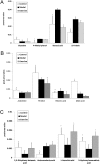GC/MS-based metabolomics strategy to analyze the effect of exercise intervention in diabetic rats
- PMID: 31042671
- PMCID: PMC6528492
- DOI: 10.1530/EC-19-0012
GC/MS-based metabolomics strategy to analyze the effect of exercise intervention in diabetic rats
Abstract
Metabolomics was used to explore the effect of exercise intervention on type 2 diabetes. The rat model of type 2 diabetes was induced by an injection of streptozocin (30 mg/kg), after fed with 8-week high-fat diet. The rats were divided into three groups: the control group, the diabetic model group (DM) and the diabetes + exercise group (DME). After exercise for 10 weeks, blood samples were collected to test biomedical indexes, and 24-h urine samples were collected for the metabolomics experiment. In the DME group, fasting blood glucose (FBG), both total cholesterol (TC) and total plasma triglycerides (TG), were decreased significantly, compared with those in the DM group. Based on gas chromatography-mass spectrometry (GC/MS), a urinary metabolomics method was used to study the mechanism of exercise intervention on diabetes mellitus. Based on the principal component analysis (PCA), it was found that the DM group and control group were separated into two different clusters. The DME group was located between the DM group and the control group, closer to the control group. Twelve significantly changed metabolites of diabetes mellitus were detected and identified, including glycolate, 4-methyl phenol, benzoic acid, 1H-indole, arabinitol, threitol, ribonic acid, malic acid, 2,3-dihydroxy-butanoic, aminomalonic acid, l-ascorbic acid and 3-hydroxy hexanedioic acid. After exercise, seven metabolites were significantly changed, compared with the control group, the relative contents of benzoic acid, aminomalonic acid, tetrabutyl alcohol and ribonucleic acid in the diabetic exercise group decreased significantly. The relative contents of 2,3-dihydroxybutyric acid, l-ascorbic acid and 3-hydroxy adipic acid increased significantly. l-ascorbic acid and aminomalonic acid which related with the oxidative stress were significantly regulated to normal. The results showed that exercise could display anti-hyperglycemic and anti-hyperlipidemic effects. The exercise had antioxidation function in preventing the occurrence of complications with diabetes mellitus to some extent. The work illustrates that the metabolomics method is a useful tool to study the mechanism of exercise treatment.
Keywords: exercise; gas chromatography-mass spectrometry; metabolomics; type 2 diabetes.
Figures




Similar articles
-
[Exploring the mechanism of rhizoma coptidis in treating type II diabetes mellitus based on metabolomics by gas chromatography-mass spectrometry].Se Pu. 2012 Jan;30(1):8-13. doi: 10.3724/sp.j.1123.2011.08039. Se Pu. 2012. PMID: 22667084 Chinese.
-
[Metabolomics analysis on serum biomarkers timing characteristics of type 2 diabetic rats intervened by exercise].Zhongguo Ying Yong Sheng Li Xue Za Zhi. 2016 Mar 8;32(3):255-259. doi: 10.13459/j.cnki.cjap.2016.03.017. Zhongguo Ying Yong Sheng Li Xue Za Zhi. 2016. PMID: 29931887 Chinese.
-
[Effects of aerobic exercise and dieting on chemerin and its receptor CMKLR1 in the livers of type 2 diabetic rats].Zhongguo Ying Yong Sheng Li Xue Za Zhi. 2017 May 8;33(5):426-430. doi: 10.12047/j.cjap.5495.2017.103. Zhongguo Ying Yong Sheng Li Xue Za Zhi. 2017. PMID: 29926587 Chinese.
-
The Effect of Exogenous Free Nε-(Carboxymethyl)Lysine on Diabetic-Model Goto-Kakizaki Rats: Metabolomics Analysis in Serum and Urine.J Agric Food Chem. 2021 Jan 20;69(2):783-793. doi: 10.1021/acs.jafc.0c06445. Epub 2021 Jan 5. J Agric Food Chem. 2021. PMID: 33401897
-
[Metabolomics study of Danggui Buxue Tang on treatment of type 2 diabetes mice using UHPLC-Q-TOF-MS].Zhongguo Zhong Yao Za Zhi. 2020 Feb;45(3):636-644. doi: 10.19540/j.cnki.cjcmm.20191105.202. Zhongguo Zhong Yao Za Zhi. 2020. PMID: 32237524 Chinese.
Cited by
-
Metabolomic Profiling Reveals That Exercise Lowers Biomarkers of Cardiac Dysfunction in Rats with Type 2 Diabetes.Antioxidants (Basel). 2024 Sep 26;13(10):1167. doi: 10.3390/antiox13101167. Antioxidants (Basel). 2024. PMID: 39456421 Free PMC article.
-
Temporal metabolic response yields a dynamic biosignature of inflammation.iScience. 2021 Jul 7;24(8):102817. doi: 10.1016/j.isci.2021.102817. eCollection 2021 Aug 20. iScience. 2021. PMID: 34355150 Free PMC article.
-
Circulating metabolomic markers in association with overall burden of microvascular complications in type 1 diabetes.BMJ Open Diabetes Res Care. 2024 Apr 11;12(2):e003973. doi: 10.1136/bmjdrc-2023-003973. BMJ Open Diabetes Res Care. 2024. PMID: 38604732 Free PMC article.
-
Unveiling the metabolic landscape of pulmonary hypertension: insights from metabolomics.Respir Res. 2024 May 28;25(1):221. doi: 10.1186/s12931-024-02775-5. Respir Res. 2024. PMID: 38807129 Free PMC article. Review.
-
Plasma Metabolomics Reveals Diagnostic Biomarkers and Risk Factors for Esophageal Squamous Cell Carcinoma.Front Oncol. 2022 Feb 7;12:829350. doi: 10.3389/fonc.2022.829350. eCollection 2022. Front Oncol. 2022. PMID: 35198450 Free PMC article.
References
LinkOut - more resources
Full Text Sources
Miscellaneous

